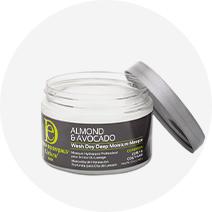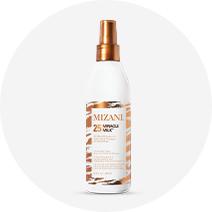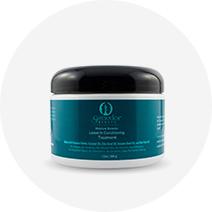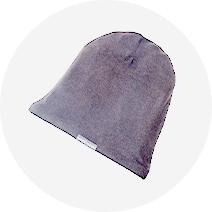Textured Hair Glossary
The Big Chop
It's an act of cutting off chemically processed or damaged hair to reveal your true, natural hair texture. It means your hair might go shorter than anticipated and typically transition for a couple of months before cutting your hair. In other words, this process is the easiest way to go 100% natural.
Breakage
Hair breakage is a situation where your hair shaft breaks. Can result in split ends and your hair strands become shorter. The tighter the curl, the more fragile the hair can be. Other factors like friction, heat, color, and chemical processing can also cause breakage.
Carving and slicing
It's a technique that involves cutting curls at a specific angle of the curve pattern to remove the bulk from the sides. It also enhances the natural curl for a more defined look and allows the ringlets to fit gently into each other.
Ceramide
It's a type of lipid found in hair and a natural component found in the cuticle. It's the outermost layer that protects and offers strength to the hair shaft. For fragile and weak hair, using products with ceramide can help restore strength.
Clarify
Clarifying is a process of stripping away the buildup of other products from your hair with the help of clarifying shampoo. It results in increased hair thickness, easier to style, and adds bounce to the curls. But, do not use the product more than once every week or two since it is more intense than regular.
Co-Wash
Also, known as conditioner-only washing is an act of washing your hair with only conditioner instead of a shampoo. For dry curl types, such a process helps retain moisture in hair and prevents the stripping of natural oils.
Clumping
Clumping is when your curls come together to form bunches or clumps. The more strands per clump the bigger your curls and easier it to style your curl definition.
Curl Type
We all know that every curl type is unique. Although you can define them in four different types including straight, wavy, curly, and tightly coiled.
Cuticle
It's the most outermost part of the hair shaft formed mostly of dead cells, overlapping in layers. It's the protective layer that locks in moisture. In curly hair, the cuticles are naturally lifted, which is why the hair experiences dryness and frizz.
Deep condition
Curly hair is naturally a little drier than straight hair. Deep condition is a treatment method that aims to nourish your hair using a good conditioner. It locks in the moisture and restores nutrients to the hair.
Density
It refers to how many strands of hair grow per square inch of your scalp. Low-density hair appears thin, and the scalp may be visible; high-density hair is often tricky to part.
Diffuser
It's an attachment for your blow dryer that disperses the airflow evenly to reduce frizz and maintain the natural curl pattern.
Elongate
It simply means to elongate the curls. An act of using a specific product or styling tool to stretch curls that are prone to shrinkage.
Frizz
It's a state of curl when all the different individual hair fibers are running in multiple directions due to lack of moisture, humidity, damage, or other factors.
Gel cast
It’s a coat formed on your hair after it hardens into a crunchy cast. With high-quality gels, the cast can be broken by closed palms over the hair to leave soft and defined curls.
Humectant
It's a common moisturizing agent used in shampoos and other beauty products. It can retain moisture by attracting water molecules to the hair.
PH
An abbreviation for potential hydrogen – it's a scale of measurement to know how acidic or alkaline a substance is. Go for a low level of pH shampoos that ranges from 4.5 to 6 to help curls maintain healthy pH and not strip away the natural oils.
Pineapple
A term specifically coined for curls is a technique to protect your hair from frizz and tangle while you sleep at night. Tie your curls into a high ponytail and slip a scrunchie over the base.
Porosity
It's your hair's ability to absorb and retain moisture. It affects how well oils and moisture pass in and out the outermost layer of your hair.
Protein
Known as the building block of your hair (e.g Keratin) which is primarily made of and strengthens your hair. Curly hair is prone to dryness which makes it important for a regular protein treatment.
Rake and Shake
It's a styling method for defining curls for every curl type. Rake a styling gel or hair cream through your curls from roots to the end. Then, grip the ends and shake back to allow curls to form.
Sebum
It's the coil secretion produced by your scalp. In curls, the shape prevents the oil to travel to the tip of your hair leaving it dry, especially after a wash. Which makes it important to rely on moistening products for curly hair.
Slip
It refers to how lubricated a product makes you feel after applying. They are primarily used to describe hair products such as conditioners or leave-in conditioners, which are applied for detangling and lock in moisture.
Sulfate
A foaming agent normally used in shampoos which can sometimes strip away the hair of its natural oils. There are different types of sulfate, namely – sodium lauryl sulfate, ammonium laureth sulfate, and so on.
Silicon
It's a type of chemical used across hair care products to provide shine and lubrication. It helps hair feel soft to touch and create shine, detangle, and seal cuticles.
Transition
It's the change from chemically treated or straightened hair to naturally textured curls. It may take months or years to transition to natural hair and healthy hair growth in the scalp.





